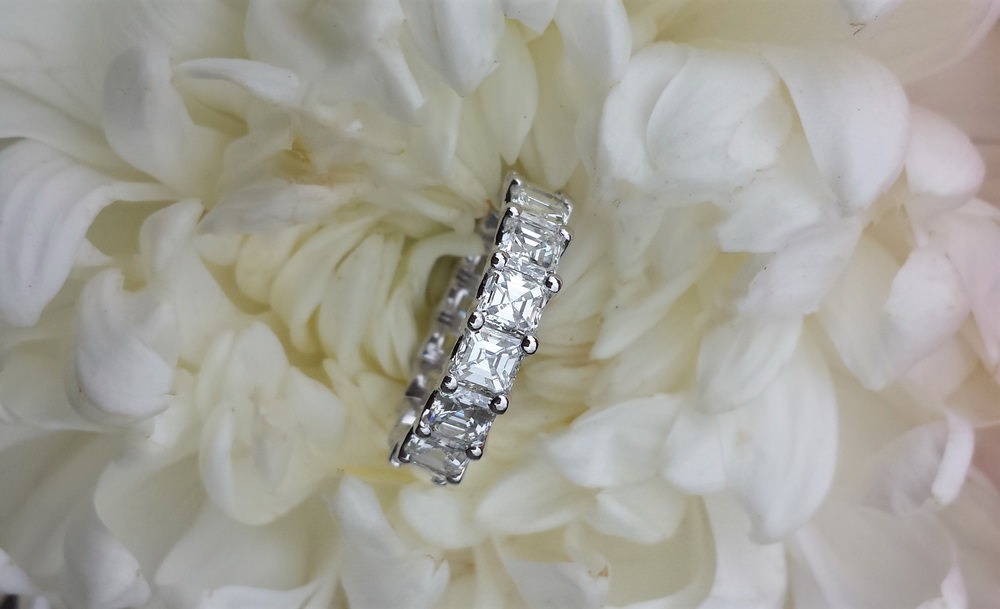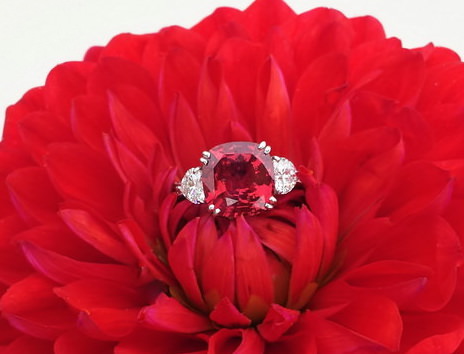-
PLATINUM
Should you choose platinum?Platinum has been synonymous with luxury and opulence for Centuries. Ancient Egyptians first demonstrated mastery of processing platinum by decorating a box with ornate platinum hieroglyphics for High Priestess Schepenupet who ruled Upper Egypt from 754 to 714BC. Today, it enjoys the cachet of being the finest and noblest of metals, representing the ultimate statement in jewellery naturally prized for its rarity, strength and striking cool white sheen.
It has been called "the only metal fit for Kings" by Louis XVI and "the difficult metal" by jewellers. A fascinating metal, platinum is one of unrivalled advantages but also one to beware of in certain situations. Below is helpful information about platinum, the number one mistake - a fatal mistake - with platinum, and how to ensure you get the best from your platinum jewellery.
What are the advantages of platinum?
Platinum is the perfect setting for diamonds in a number of ways. It has remarkable tensile strength, the ability to withstand stress; even very thin sections of platinum can retain their shape. This is perhaps its greatest jewellery advantage making it possible to set gems with the least amount of metal on claws white still providing sufficient structural stability to assure a durable and functional jewel. A key advantage if your setting is delicate or you dislike beefy claws. Tensile strength makes possible the true tension setting in which a diamond is suspended and held in place by nothing more than the two sides of the ring shank because a platinum band will not deform over time. This style of setting is often simulated in white gold but the gold must be grooved slightly to hold the stone.
The low reflection point means platinum does not reflect its surroundings allowing your diamond's full brilliance to be seen perfectly. This is less a factor with coloured gemstones or strongly coloured fancy diamonds but a crucial advantage with colourless diamonds, particularity those cuts most depending on brilliance for their characteristic beauty such as the emerald cut and Asscher cut.

Asscher diamond band in platinum from the DEEDEE Collection
Platinum has a dead-set or no-spring back characteristic. Unlike gold, it will not spring back when hammered or pressed down over a stone during setting, making for tight settings that do not loosen up over time. For this same reason, it is also a more forgiving metal for setting delicate stones such as emerald.
Its inherent malleability and ductility, combined with tensile strength, allow a jeweller to produce intricate designs drawing platinum into finer details than possible with other metals. It also retains those details over the years because polishing with a soft cloth does not remove any layers from platinum, as it does with gold, thus platinum's historical popularity for fine Edwardian filigree settings.
In addition to these four principle advantages there are other benefits as well, such as the fact it retains its natural and distinctive white colour through the years. It is hypoallergenic, does not tarnish and will not react with chlorine, thus it can be worn every day with ease and without special maintenance. This is most important if you have metal sensitivity or are not in the habit of removing jewellery for bathing, athletics, household chores and vigorous activities. Platinum's extraordinary density and durability means fewer repairs; however, it is not indestructible, all metals including platinum will scratch and dent with heavy wear or contact with hard or sharp objects. Some love the slightly worn look on platinum saying it betters with age as a stunning patina develops over time. Others dislike it and will need to polish it regularly. Depending on how often you will do this, platinum can offer an important advantage because it will not thin by lightly polishing it repeatedly. Excessive polishing wears down gold much more readily.
Is the "Fit for Kings" the fit for you?
Many hold platinum is always the superior choice and market it that way. But is that true? Yes and no. In reality, it depends on the application. Obviously with highly detailed and intricate designs or tension settings it would be an obvious choice because its properties make it ideal; however, with other jewellery just because you can make it out of platinum does not mean you should. Before you decide on platinum consider all factors.
The Weight of Luxury
Platinum is a great deal heavier than gold. PT900 is 60% heavier than an equal volume of 14K gold. Many prefer the exceptional heft of platinum terming it the "weight of luxury." Yet, there are others who find it too heavy, particularly for big rings and earrings.
Platinum is a premium price point metal, typically two to three times more expensive than gold because of several factors. First, it is a more expensive metal per gram to begin. Second, it is denser and therefore requires more weight per equal volume than gold so the same ring will weigh more and cost more per gram. Next, it takes longer to polish and finish. It also requires greater skill and knowledge of specialized techniques to produce a quality piece. And further, it is more expensive to work with because special crucibles, separate tools and torches capable of exceptional high heat are required.

Stunning platinum ruby and diamond ring from the DEEDEE Collection
These are the two factors often considered under disadvantages: weight and premium price. But they're not really disadvantages. They're simply matters of personal preference; neither advantage nor disadvantage. For every person who finds it too heavy, there is one who loves it for that exact reason. The same is true with its exclusive price.
Here then is the only potential true disadvantage to platinum. And it's no fault of the metal.
Beware the "difficult metal"
With platinum the devil is in the details. In the things many other jewellers never tell you. And there's a reason they don't tell you. Above it was mentioned that platinum is a premium price metal because it requires greater skill and knowledge of specialized techniques to produce a quality piece. So you're thinking, "No problem there, if I can afford it, everything's perfect." Not so fast. This is where it gets interesting.
As with gold, pure platinum is too soft for use in jewellery but it requires only little mixing with other metals to make alloy hard enough to be functional. Most jewellery platinum is 90-95% pure, whereas the purest of traditional fine jewellery gold is 18K and 75% pure. Platinum purity is expressed in parts per 1000 prefixed with PT. By this convention, PT900 is 90% pure, representing 900 parts platinum per 1000; PT950 is 95% pure, representing 950 parts platinum per 1000. The other metals are typically cobalt, palladium, rhodium, iridium, and ruthenium.
If pure platinum is too soft and alloy platinum is durable, then the 50-100ppt of the alloy that is not platinum is therefore all important. That adds the critical technical properties. This is the number one mistake with platinum: when cast by an inexperienced craftsman platinum is rather soft and porous and its appearance is actually similar to sponge toffee although you wouldn't notice this right away. A ring may look fine after initial polishing and finishing when you first get it but after a month of normal wear it begins to compact and compress resulting in a surface that is deformed.
Depending on the manufacturing method, some alloys are more favourable than others. Cobalt lowers the alloy melting point, improves fluidity in casting and makes the alloy very slightly greyer. Platinum-cobalt alloy can create very finely cast pieces as it fills extremely well during the casting process and will be hard and durable when finished. Platinum 900/100 iridium or platinum 950/50 ruthenium is appropriate for casting and even whiter; however, platinum 950/50 iridium is unsuitable. Platinum increases in hardness as you work it and cast pieces require little additional work - usually just cleaning and polishing - so the metal will not be hardened sufficiently. Both platinum 950/50 iridium or platinum 950/50 palladium are simply too soft as a finished product if used for casting. But for hand fabrication, platinum 950/50 iridium is a great choice, as the metal will be work-hardened by hammering and rolling it.
We have seen alloy mistakes quite often during appraisal and repairs. A client with a misshapen ring or a broken claw and a lost gemstone saying in disbelief "but, it's platinum!" Yes, but the issue is not whether it is platinum, the issue is what specific alloy it is and whether or not the person who made it for you was properly skilled. Your platinum simply won't have the exceptional benefits outlined in this article - most significantly tensile strength and durability - if inexperience produced it. All platinum alloy is difficult to work with, all of it. It requires special techniques whether casting or hand fabricating. This is aggravated by the fact that platinum contaminates easily from other metals because they melt into platinum readily at the high temperature required (1768 ℃ vs 1064 ℃ for gold) and contaminated platinum doesn't wear well either.
Many people can make platinum jewellery but only highly skilled people should make it. It's the difference between you loving your platinum jewellery forever versus seeing it deform and wear out much before its time. Never pick the low-cost provider mistaking that platinum is platinum. It is not. Skill is worth paying for and with platinum skill matters most. If you're unwilling to invest in high-quality platinum, white gold is the perfect alternative. You will be much happier with a quality white gold ring than a compromised platinum ring.
We ensure the highest quality. Speak with us today. We can answer your questions and help you make your own spectacular perfectly crafted creation.
FUN FACTS
Platinum is so dense that a six inch cube weighs 165 pounds.
A cylindrical hunk of platinum and platinum alloy is used as the "International Standard" for measuring a kilogram. About 40 of these cylinders are distributed around the world.
All the platinum ever mined would fit in an average sized living room.
Jewellery is only platinum's second largest usage; the first is catalytic converters which are devices that control harmful vehicle emissions.
Ten tons of ore are required to produce a single ounce of platinum and the process takes 8 weeks.

Loading...
